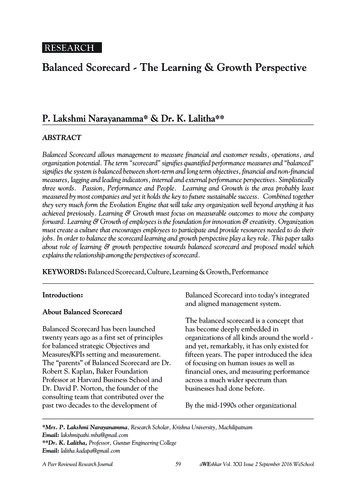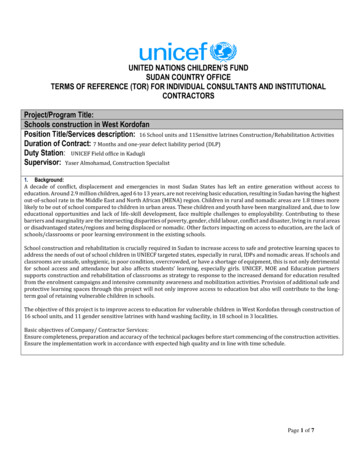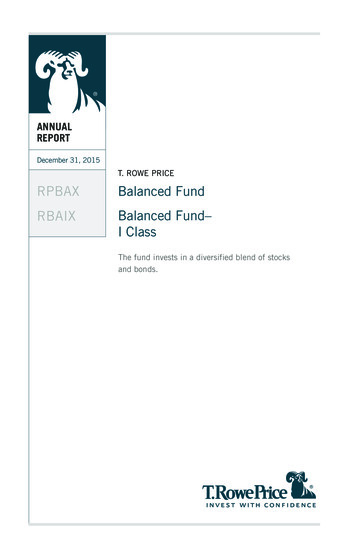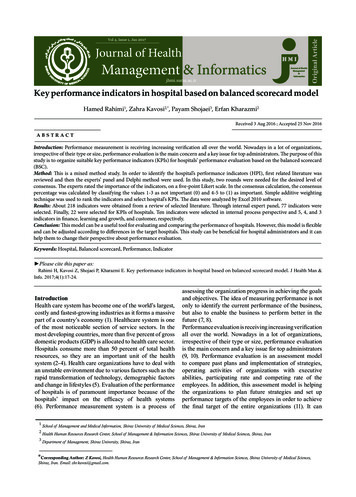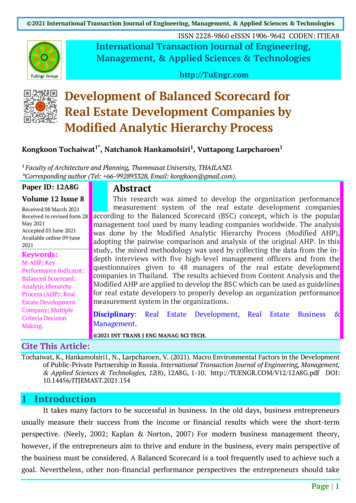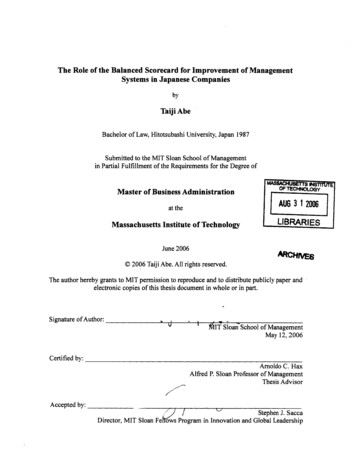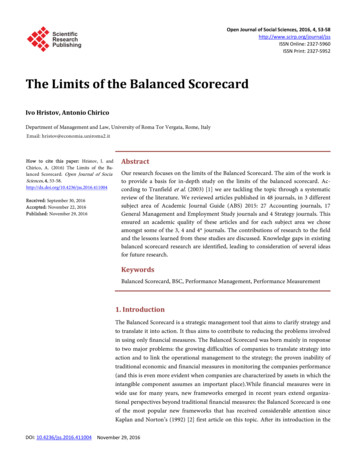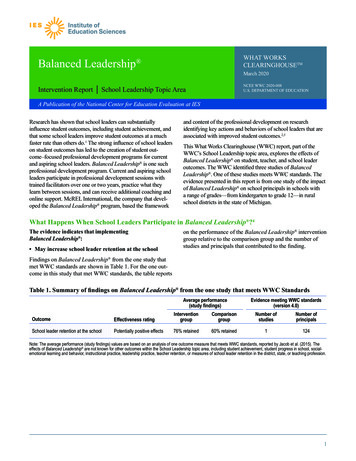
Transcription
Balanced Leadership WHAT WORKSCLEARINGHOUSETMIntervention Report School Leadership Topic AreaNCEE WWC 2020-008U.S. DEPARTMENT OF EDUCATIONMarch 2020A Publication of the National Center for Education Evaluation at IESResearch has shown that school leaders can substantiallyinfluence student outcomes, including student achievement, andthat some school leaders improve student outcomes at a muchfaster rate than others do.1 The strong influence of school leaderson student outcomes has led to the creation of student outcome–focused professional development programs for currentand aspiring school leaders. Balanced Leadership is one suchprofessional development program. Current and aspiring schoolleaders participate in professional development sessions withtrained facilitators over one or two years, practice what theylearn between sessions, and can receive additional coaching andonline support. McREL International, the company that developed the Balanced Leadership program, based the frameworkand content of the professional development on researchidentifying key actions and behaviors of school leaders that areassociated with improved student outcomes.2,3This What Works Clearinghouse (WWC) report, part of theWWC’s School Leadership topic area, explores the effects ofBalanced Leadership on student, teacher, and school leaderoutcomes. The WWC identified three studies of BalancedLeadership . One of these studies meets WWC standards. Theevidence presented in this report is from one study of the impactof Balanced Leadership on school principals in schools witha range of grades—from kindergarten to grade 12—in ruralschool districts in the state of Michigan.What Happens When School Leaders Participate in Balanced Leadership ?4The evidence indicates that implementingBalanced Leadership : May increase school leader retention at the schoolon the performance of the Balanced Leadership interventiongroup relative to the comparison group and the number ofstudies and principals that contributed to the finding.Findings on Balanced Leadership from the one study thatmet WWC standards are shown in Table 1. For the one outcome in this study that met WWC standards, the table reportsTable 1. Summary of findings on Balanced Leadership from the one study that meets WWC StandardsAverage performance(study findings)Evidence meeting WWC standards(version 4.0)OutcomeEffectiveness ratingInterventiongroupComparisongroupNumber ofstudiesNumber ofprincipalsSchool leader retention at the schoolPotentially positive effects76% retained60% retained1124Note: The average performance (study findings) values are based on an analysis of one outcome measure that meets WWC standards, reported by Jacob et al. (2015). Theeffects of Balanced Leadership are not known for other outcomes within the School Leadership topic area, including student achievement, student progress in school, socialemotional learning and behavior, instructional practice, leadership practice, teacher retention, or measures of school leader retention in the district, state, or teaching profession.1
BOX 1. HOW THE WWC REVIEWS AND DESCRIBES EVIDENCEThe WWC evaluates evidence based on the quality and results of reviewed studies. The criteria the WWC uses for evaluatingevidence are defined in the Procedures and Standards Handbooks and the Review Protocols. The studies summarized in this reportwere reviewed under WWC Standards (version 4.0) and the School Leadership topic area protocol (version 4.0).To determine the effectiveness rating, the WWC considers what methods each study used, the direction of the effects, and thenumber of studies that tested the intervention. The higher the effectiveness rating, the more certain the WWC is about the reportedresults and about what will happen if the same intervention is implemented again. The following key explains the relationship betweeneffectiveness ratings and the statements used in this report:Effectiveness RatingRating interpretationDescription of the evidencePositive (or negative) effectsThe intervention is likely to change anoutcomeStrong evidence of a positive effect, with nooverriding contrary evidencePotentially positive (or negative) effectsThe intervention may change an outcomeEvidence of a positive effect with no overridingcontrary evidenceNo discernible effectsThe intervention may result in little to nochange in an outcomeNo affirmative evidence of effectsMixed effectsThe intervention has inconsistent effectson an outcomeEvidence includes studies in at least two ofthese categories: studies with positive effects,studies with negative effects, or more studieswith indeterminate effects than with positive ornegative effectsHow is Balanced Leadership Implemented?The following section provides details of how BalancedLeadership was implemented. This information canhelp educators identify the requirements for implementingBalanced Leadership and determine whether implementing this intervention would be feasible in their district orschool. Information on Balanced Leadership presentedin this section comes from the study that meets WWCstandards (Jacob et al., 2015) and from correspondence withthe developer. Goal: Balanced Leadership aims to improve studentoutcomes by helping current and aspiring school leadersunderstand and implement a set of actions and behaviorsof school leaders that may be associated with improvedstudent outcomes. Target population: The Balanced Leadership programreviewed in this report is intended for principals, assistant principals, teacher leaders, and others responsiblefor school-level leadership in schools serving kindergartenthrough grade 12. A separate Balanced Leadership program offered by the developer seeks to engagedistrict-level leaders. Method of delivery: Balanced Leadership instructionalspecialists provide professional development to groupsof school leaders during in-person sessions offered at alocation the school district provides or in a central locationif multiple districts are participating together (referred to asthe consortium model). School leaders can receive additionalComparison group: In the study that contributes tothis intervention report, principals in the comparisongroup received their school or district’s standard professional development offerings. Several comparisongroup principals described attending a program withcontent similar to Balanced Leadership .one-on-one coaching and online support. In the study thatcontributes to this intervention report, the sessions tookplace in two central locations close to the participatingschool districts. Frequency and duration of service: The program iscustomizable, and the number of sessions offered dependson what the school or district requests. In the study thatcontributes to this intervention report, principals attended10 sessions, each of which was offered over 2 days.Though the program is offered over 2 years, the sessionsin this study took place across parts of 3 school years. Thestudy does not describe any additional coaching or onlinesupport provided by the program. Intervention components: Balanced Leadership includesseveral components, as noted in Table 2. A separate program for district-level leaders, which can be bundled withthe school-level leader program, is also described below,but was not the subject of the study that contributes to thisintervention report.2
Table 2. Components of Balanced Leadership Key componentDescriptionFramework for actionsand behaviors ofschool leadersThe professional development focuses on 21 specific actions and behaviors of school leaders that may be associated withimproved student outcomes, including designing and implementing school curriculum, instruction, and assessment; fosteringshared beliefs and community; and monitoring teaching and student learning.On-site professionallearning for schoolleaders in year oneDuring the first year, current or aspiring school leaders are offered between one and four two-day on-site professional learningsessions focused on the 21 specific actions and behaviors that may be associated with improved student outcomes. The firstsession provides an overview of the program and each of the actions and behaviors of school leaders. The second throughfourth sessions, in turn, focus on learning how to initiate and lead school change, maintain a focus on school performance,and foster shared beliefs and a purposeful school community. The structured training sessions are offered using a case studyapproach, in which participants read about and reflect on real-life applications of the leadership framework.On-site professionallearning for schoolleaders in year twoFor schools that participate in 2 years of the program, sessions in the second year focus on extending and refining the topicscovered in the first year through group discussions, case studies, and action plans. These activities are offered over two to sixprofessional learning sessions, each offered over 2 days. Coaching and additional online supports are available throughoutthe program as requested by the school or district.Training for districtstaffThe program can also include professional development for district-level leaders, for example, superintendents or assistantsuperintendents, who oversee multiple schools. The district-level training, provided over 1 to 4 days, focuses on settinggoals, strategies for supporting school leaders, and effective management practices. District staff can also become trainedfacilitators in the Balanced Leadership program themselves, in order to sustain the program in their districts over time.What Does Balanced Leadership Cost?The cost of participating in Balanced Leadership variesdepending on the number of school leaders being trainedand the extent of program customization. The program canbe implemented using a consortium training model, in whichschool leaders from multiple districts attend the training ina central location, to lower program costs to individualdistricts. The preliminary list of cost drivers in this sectionis not designed to be exhaustive; rather, it provides educatorsan overview of the major resources needed to implementBalanced Leadership . Actual program costs are onlyavailable in consultation with the developer. The informationdescribed below is based on the information available as ofJuly 2019. Equipment and materials costs: Participants receiveactivity guides, manuals, and access to online resources aspart of the contracted cost. Personnel costs: McREL provides facilitators to leadBalanced Leadership professional learning sessions and coaching activities. Each participating school leader joinsup to 10 professional learning sessions over 2 years, andadditional coaching sessions are available as part of thecontracted cost.Facilities costs: Professional development activities occurin a school or administrative building in the school leaders’district. For the consortium training model, the trainingoccurs in a centrally located facility provided by one ofthe districts, or a regional education agency. Schools anddistricts are responsible for transportation to and fromthese locations.Costs paid by students or parents: None.In-kind supports: None.Sources of funding: Schools and districts usually coverthe contracted costs for Balanced Leadership usinggeneral funds or any grant funds they may have available.For More Information:About Balanced Leadership McREL International4601 DTC Boulevard; Suite 500Denver, CO 80237-2596Email: info@mcrel.org. Web: www.mcrel.org/balancedleadership/. Phone: (800) 858-6830.About the cost of the interventionActual program costs are only available in consultation with the developer.3
Research SummaryThe WWC identified three studies that investigated the effectiveness of Balanced Leadership (Figure 1):WWC standards or are ineligible for review do not contributeto the effectiveness ratings. One study meets WWC group design standards withoutreservationsThe one study of Balanced Leadership that meets WWCgroup design standards reported findings on school leaderretention at the school. No other findings in the study withinany outcome domain included in the School Leadership topicarea met WWC group design standards.5 The citation forthe study reviewed for this report is listed in the Referencessection on page 8. Citations for the two studies that are ineligible for review and the reasons the WWC determined theywere ineligible are also listed in the References section. Two studies are ineligible for reviewThe WWC reviews findings on the intervention’s effects oneligible outcome domains from studies that meet standards,either with or without reservations. Based on this review, theWWC generates an effectiveness rating, which summarizeshow the intervention impacts, or changes, a particular outcome domain. Findings from studies that either do not meetFigure 1. Effectiveness ratings for Balanced Leadership meets WWCmeet WWCdo not1 study0 studies0 studiesstandards withoutstandards withmeet WWCreservationsreservationsContribute to effectiveness ratingsstandardsare2 studiesineligible forreviewDo not contribute to effectiveness ratingsBalanced Leadership has potentially positive effects on school leader retention at the schoolThe WWC determined that one study that meets WWC group design standards without reservations shows evidence ofa positive effect of Balanced Leadership on school leader retention at the school with no overriding contrary evidence(Jacob et al., 2015).[Intervention] has [effects] on .Text[Intervention] has [effects] on .Text4
Main FindingsTable 3 shows the findings from one Balanced Leadership study that meets WWC standards. The table includes WWCcalculations of the mean difference, effect size, and performance of the intervention group relative to the comparisongroup. Based on findings from this study, the effectivenessrating for school leader retention at the school is potentiallypositive effects, indicating evidence of a positive effect withno overriding contrary evidence. This finding is based on124 school principals.Table 3. Findings by outcome domain from the one study of Balanced Leadership that meets WWC StandardsMean(standard deviation)Measure (study)Principal turnoverat the schoolafter 3 years(Jacob et al., 2015)aWWC calculationsStudy l principals12424%40%–160.45 17.100.45 17Outcome average for school leader retention at the schoolNotes: For principal turnover, lower mean scores indicate more favorable results; the WWC-calculated findings on school leader retention in Table 1 and the effect size andimprovement index reported in this table are adjusted so that a positive number favors the intervention group. The effect size is a standardized measure of the effect of anintervention on outcomes, representing the average change expected for all individuals who are given the intervention (measured in standard deviations of the outcomemeasure). An indicator of the effect of the intervention, the improvement index is a standardized measure of the relative performance of the intervention group to the comparisongroup in percentile terms. A positive number favors the intervention group. For example, an improvement index of 17 means that the expected percentile rank of the averagecomparison group principal would increase by 17 points if the principal received Balanced Leadership . A positive improvement index does not necessarily mean the estimatedeffect is statistically significant.aThe findings in Jacob et al. (2015) did not require corrections for clustering, multiple comparisons adjustments, or difference-in-differences adjustments. The unadjusted meansand sample sizes presented here were provided in response to an author query. This study is characterized as having a potentially positive effect on school leader retention atthe school because there is evidence of a positive effect with no overriding contrary evidence. For more information, please refer to the WWC Procedures Handbook, version4.0, page 22.5
In What Context Was Balanced Leadership Studied?The following section provides information on the setting of the one study of Balanced Leadership that meetsWWC standards, and a description of the participants in theresearch. This information can help educators understandthe context in which the study of Balanced Leadership wasconducted, and determine whether the program might besuitable for their setting.WHERE THE STUDY WAS CONDUCTED1 study, 124 public schools across as many as 74 school districts in northern MichiganRural districtsStudent RacePrincipal Race90%10%100%WhiteMinorityWhiteFree & Reduced-Price Lunch: 47%GradesPKK12Principals with Graduate Degrees: 77%3456789101112PSGrades K–12Details of Each Study that Meets WWC StandardsThis section presents details for the study of BalancedLeadership that meets WWC standards. These detailsinclude the full study reference, findings description, findingssummary, and description of study characteristics. A summary of domain findings for the study is presented below,followed by a description of the study characteristics. Thesestudy-level details include contextual information around thestudy setting, methods, sample, intervention group, comparison group, outcomes, and implementation details. For additional information, readers should refer to the original study.Research details for Jacob et al. (2015)Jacob, R., Goddard, R., Kim, M., Miller, R., & Goddard Y.(2015). Exploring the causal impact of the McREL BalancedLeadership program on leadership, principal efficacy, instructional climate, educator turnover, and student achievement.Educational Evaluation and Policy Analysis, 37(3), 314-332.Retrieved from https://eric.ed.gov/?id EJ1072764.Findings from Jacob et al. (2015) show evidence of potentially positive effects of Balanced Leadership on schoolleader retention at the school (Table 4). This finding is basedon an outcome analysis that includes 124 principals. Thefinding and research details summarized for this study comefrom two related citations, including the primary study listedabove. See the References section on page 8 for a list of allrelated publications.Table 4. Summary of findings from Jacob et al. (2015)Meets WWC Group Design Standards Without ReservationsStudy findingsOutcome domainSchool leader retention at the schoolSamplesizeAverageeffect sizeImprovementindexStatisticallysignificant124 principals0.45 17No6
Table 5. Description of study characteristics for Jacob et al. (2015)WWC evidenceratingMeets WWC Group Design Standards Without Reservations. This is a randomized controlled trial (RCT) with lowattrition.6 For more information on how the WWC assigns study ratings, please see the WWC Procedures and StandardsHandbooks (version 4.0) and WWC Standards Briefs, available on the WWC website.SettingThe study includes 124 rural schools spread across as many as 74 school districts in northern Michigan, includingthe Upper Peninsula. Only schools that were public (including charter or magnet) and served grades 3 to 5 inclusively(for example, K–5 or K–12) were eligible to participate in the study.MethodsThis study is an RCT that assigned schools and their principals to intervention or comparison conditions. Of 126 schoolsand principals recruited for the study, approximately half were randomly assigned to an intervention group in whichthe principals participated in the Balanced Leadership program, and half to a “business as usual” comparison group.Recruitment was conducted by contacting superintendents who then signed a letter of agreement allowing their principalsto participate. Principals were then contacted and invited to participate in the study.Random assignment was conducted using a stratified approach. Researchers placed the 126 schools into 12 groups basedon proximity to an urban center (the degree of rurality) and socioeconomic status. Schools within each group were assigneda random number and then ordered accordingly from lowest to highest. The first half of the schools in each sorted list wasassigned to the intervention group; the second half was assigned to the comparison group. After assignment, 62 schoolswere in the Balanced Leadership intervention group and 64 schools were in the business-as-usual comparison group.The sample loss after random assignment (attrition) was within the acceptable threshold for the review: the overall attritionrate was 2% and differential attrition was 3 percentage points. A total of 124 schools and principals remained in the analysisafter 3 years.Study sampleOne hundred twenty-four schools participated in the study for all 3 years. This included 124 principals, as many as1,764 teachers, and more than 30,000 students. Outcomes using the analytic samples of teachers and students did notmeet WWC group design standards to be included in this review.In study schools, which averaged 300 students each, approximately 47% of students were eligible for the free- or reducedprice meal program and 10% were minorities. Forty-three percent of principals were female, 77% had advanced degrees,and all were White. No descriptive information was provided for the sample of teachers.InterventiongroupPrincipals in the intervention group were offered 10 Balanced Leadership program sessions, each of which took placeover 2 days. These sessions were spread across 3 academic years, starting in January 2009 (the 2008–09 school year)and ending in October 2010 (the 2010–11 school year). The consortium training model was used, with principals attendingtraining together at one of two locations closest to their districts.ComparisongroupNo alternative intervention was designed for the comparison schools. Principals in those schools received their school ordistrict’s standard professional development offerings. Of the school principals in the comparison group, 12% reportedattending a program with content similar to the intervention.Outcomes andmeasurementStudy authors reported findings on one outcome measure that is eligible for review under the School Leadership topic area andmet WWC group design standards. This outcome, principal turnover at the school, was reviewed in the school leader retentionat the school domain. Principal turnover between the baseline year (the 2008–09 school year) and the end of the third year ofthe study (the 2010–11 school year) was assessed using administrative data from the Michigan Department of Education.The study also reported findings for teacher turnover, which was reviewed in the teacher retention at the school domain.This outcome did not meet WWC group design standards because teachers joining study schools after random assignmentmay have posed a risk of bias, and the authors do not present information to confirm that the analytic sample of teachers inthe intervention and comparison groups is equivalent at baseline.In addition, the study reported findings for a survey of principal leadership and school climate as reported by principalsand teachers. These findings were not eligible for review in the leadership practice domain. Eligible measures in thisdomain must demonstrate a link between the measure and a student outcome (for example, student achievement), but thisinformation was not available.7Finally, the study reported findings for student achievement on math and reading standardized tests in grades 3–5. Theseoutcomes did not meet WWC group design standards because the authors do not present information the WWC needed toassess the risk of bias due to nonresponse of students.AdditionalimplementationdetailsThe Balanced Leadership professional development sessions were facilitated by full-time training consultants employedby the program developer. Training consultants were required to complete practice training sessions with more experiencedfacilitators before they were allowed to facilitate sessions in the field. No additional information on support for implementation isdescribed in the study.7
References3The descriptive information for this intervention comes from Jacobet al. (2015) and the intervention developer. The What WorksClearinghouse (WWC) requests developers review the intervention description sections for accuracy from their perspective. TheWWC provided the developer with the intervention description inJuly 2019 and the WWC incorporated feedback from the developer. Further verification of the accuracy of the descriptive information for this intervention is beyond the scope of this review.4The literature search reflects documents publicly available by June2019. Reviews of the studies in this report used the standards fromthe WWC Procedures and Standards Handbook (version 4.0) andthe School Leadership review protocol (version 4.0). The evidencepresented in this report is based on available research. Findingsand conclusions could change as new research becomes available.5Student, teacher, and school leader outcomes can be reviewedunder the School Leadership topic area protocol. The study thatmet WWC group design standards did not report findings that metstandards in other outcome domains. For student outcomes, thesedomains are general literacy achievement, general mathematicsachievement, general science achievement, general social studiesachievement, general achievement, English language proficiency, staying in school, progression in school, completing school,student social interaction, observed individual behavior, studentemotional status, and student engagement in school. For teacher outcomes, these domains are instructional practice, teacherattendance, teacher retention at the school, teacher retention in theschool district, teacher retention in the state, and teacher retentionin the profession. For school leaders, these outcome domains areleadership practice, school leader retention in the school district,school leader retention in the state, and school leader retention inthe profession.6This study meets WWC group design standards without reservations because one outcome (principal turnover) is from a low-attrition RCT where the risk of bias from individual nonresponseis low. Other measures in this study do not meet standards asdescribed in Table 5. This review of Jacob et al. (2015) assignedthe same study rating as the prior review of the study conductedfor the IES grant competition (based on a previous version ofthe publication released online in 2014 prior to print). This priorreview was conducted under the version 3.0 standards using theSingle Study Review Protocol (version 2.0).7The survey measure was also reviewed as a supplemental outcome;however, no survey findings from the analytic sample of principalsmet WWC group design standards because of high cluster-levelattrition from survey nonresponse and non-equivalence on severalbaseline measures from within the outcome domain. The analyticsample of teachers did not meet WWC group design standardsbecause of high cluster-level attrition from survey nonresponse.Though the authors present information to demonstrate equivalence of the clusters at baseline, they do not present informationthe WWC needed to assess the risk of bias due to nonresponse ofteachers at follow-up.Study that meets WWC group design standardsJacob, R., Goddard, R., Kim, M., Miller, R., & Goddard Y.(2015). Exploring the causal impact of the McRELBalanced Leadership program on leadership, principalefficacy, instructional climate, educator turnover,and student achievement. Educational Evaluationand Policy Analysis, 37(3), 314-332. Retrieved fromhttps://eric.ed.gov/?id EJ1072764.Additional source:Miller, R., Goddard, R., Kim, M., Jacob, R., GoddardY., & Schroeder, P. (2016). Can professionaldevelopment improve school leadership?Results from a randomized control trialassessing the impact of McREL’s BalancedLeadership program on principals in ruralMichigan schools. Educational AdministrationQuarterly, 52(4), 531-566. Retrieved fromhttps://eric.ed.gov/?id EJ1112412Studies that are ineligible for review using theSchool Leadership topic area protocolKoonce, F. (2006). A journey in instructional leadershipusing the McREL Balanced Leadership Framework asa vehicle: A beginning principal’s efforts to grow inher instructional leadership (Doctoral dissertation).Retrieved from ProQuest Dissertations and Thesesdatabase. (UMI No. 3227712) The study is ineligiblefor review because it does not use a study designeligible for review under the WWC’s group designstandards, regression discontinuity design standards,or pilot single-case design standards, as described inthe WWC Standards Handbook (Version 4.0).Miller, G. L. (2007). Effects of professional development onadministrators and school climate (Doctoral dissertation). Retrieved from ProQuest Dissertations andTheses database. (UMI No. 3287986) The study is ineligible for review because it does not use a study designeligible for review under the WWC’s group designstandards, regression discontinuity design standards, orpilot single-case design standards, as described in theWWC Standards Handbook (Version 4.0).Endnotes12Several studies describe differences across school leaders in theirimpacts on student achievement, including Dhuey and Smith(2018); Branch et al. (2012); and Leithwood et al. (2004).The research that McREL International used to identify the actionsand behaviors of school leaders associated with improved studentoutcomes includes School Leadership That Works: From Researchto Results (Marzano et al. 2005). A review of this research by theWWC is beyond the scope of this review.Recommended CitationWhat Works Clearinghouse, Institute of Education Sciences,U.S. Department of Education. (2020, March). BalancedLeadership . Retrieved from https://whatworks.ed.gov8
May increase school leader retention at the school. Findings on . Balanced Leadership from the one study that met WWC standards are shown in Table 1. For the one out-come in this study that met WWC standards, the table reports on the performance of the . Balanced Leadership intervention group relative to the comparison group and the .
